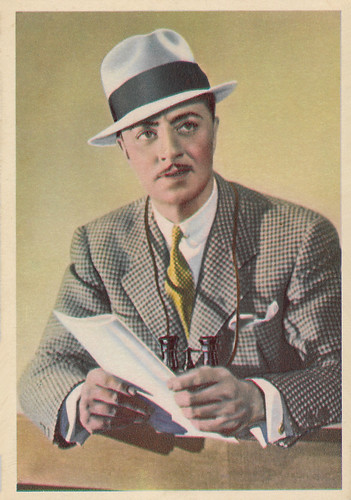
British postcard by De Reszke Cigarettes and other Godfrey Philips Associated brands, no. 2. Photo: Metro-Goldwyn-Mayer (MGM).

British postcard by Art Photo, no. 102. Photo: Metro-Goldwyn-Mayer. Myrna Loy and Wiliam Powell in After the Thin Man (W.S. Van Dyke, 1936).
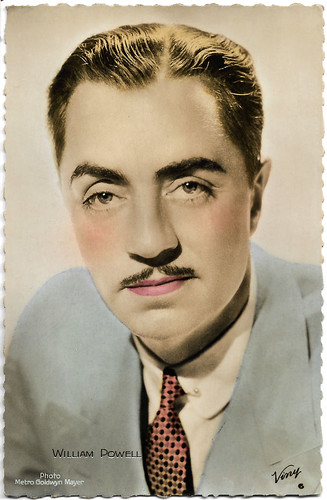
French postcard by Viny, no. 6. Photo: Metro-Goldwyn-Mayer (MGM).
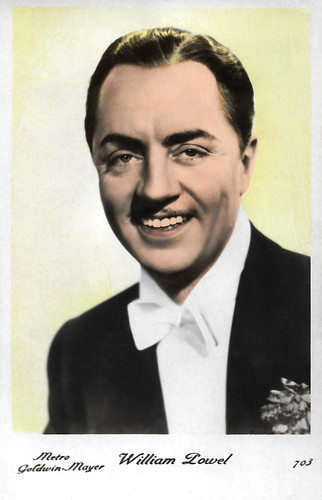
French postcard, no. 703. Photo: Metro-Goldwyn-Mayer (MGM).
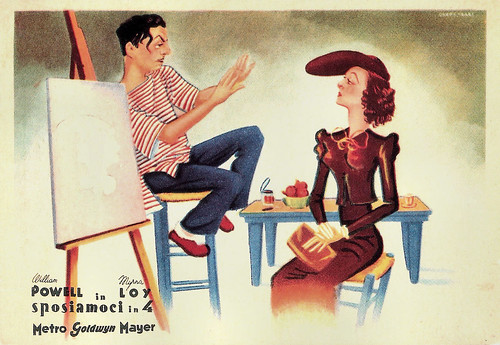
Italian postcard. Art work: Giacomo Canestrari / Metro-Goldwyn-Mayer. William Powell and Myrna Loy in Double Wedding (1937).
Thieves, blackmailers and bad husbands
William Horatio Powell was born in Pittsburgh in 1892. He was the only child of Nettie Manila (née Brady) and Horatio Warren Powell, who worked as an accountant. In 1907, young William moved with his family to Kansas City, Missouri, where he graduated from Central High School four years later. The family lived there only a few blocks away from the Carpenters, whose daughter Harlean later also went to Hollywood under the name Jean Harlow, although she and William did not meet until they were both established film actors.
Wiliam always wanted to act. After high school, he enrolled at the University of Kansas, where he intended to study law, but after only a week there, he decided to leave the school and went to New York. He was 18 when he started studying drama at the American Academy of Dramatic Arts (AADA) and graduated in 1912. He worked in some vaudeville and stock companies and then went to Broadway where he appeared in successful plays.
In 1922 he began a career in Hollywood with a small role as an evil henchman of Professor Moriarty in Sherlock Holmes (Albert Parker, 1922) with John Barrymore. He later performed as Francis I alongside Marion Davies as Mary Tudor in When Knighthood Was in Flower (Robert G. Vignola, 1922). The historic drama produced by William Randolph Hearst (through his Cosmopolitan Productions) was considered the most expensive film ever produced at the time.
In 1924 William Powell signed a studio contract with Paramount Pictures and went on to star in numerous productions, including the now-lost 1926 premiere of The Great Gatsby (Herbert Brenon, 1926), starring Warner Baxter and Lois Wilson. In the silent era, he primarily played sinister characters such as thieves, blackmailers, and bad husbands. He finally attracted attention as Leo, the arrogant film director in Josef von Sternberg's The Last Command (1928) alongside Emil Jannings.
The big success for Powell came with the advent of the talkies in the late 1920s, which also showcased his pleasant voice. In the crime mystery The Canary Murder Case (Malcolm St. Clair, Frank Tuttle, 1929), he portrayed Philo Vance, the amateur private detective best known from the novels of S.S. Van Dine, who investigates the death of "the Canary" (Louise Brooks). Powell filmed two sequels with Paramount, The Greene Murder Case (Frank Tuttle, 1929) and The Benson Murder Case (Frank Tuttle, 1930); as well as The Kennel Murder Case (Michael Curtiz, 1933) at rival studio Warner Bros.
It established him in more positive roles. Together with Kay Francis, Powell formed an on-screen pair in six films from 1930 to 1932. One of their most successful films together was the tender shipboard romance One Way Passage (Tay Garnett, 1932). In 1931, he married actress Carole Lombard, whom he divorced again in 1933. However, they remained on good terms.

French postcard by Editions et Publications cinématographiques (EPC), no. 113. Photo: MGM.
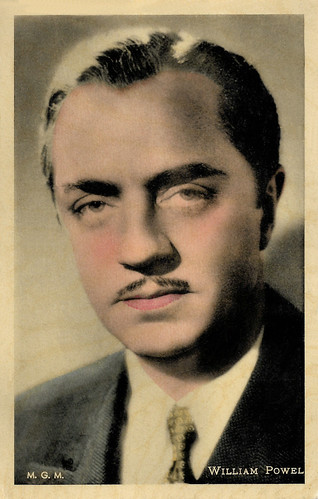
Vintage card. Photo: Metro-Goldwyn-Mayer (MGM).

British postcard in the Filmshots series by Film Weekly. Photo: Warner. Sheila Terry and William Powell in Private Detective 62 (Michael Curtiz, 1933).
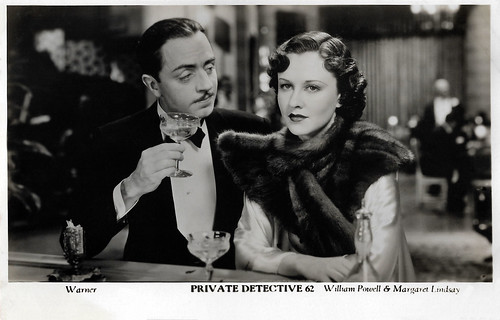
British postcard in the Filmshots series by Film Weekly. Photo: Warner. Margaret Lindsay and William Powell in Private Detective 62 (Michael Curtiz, 1933).
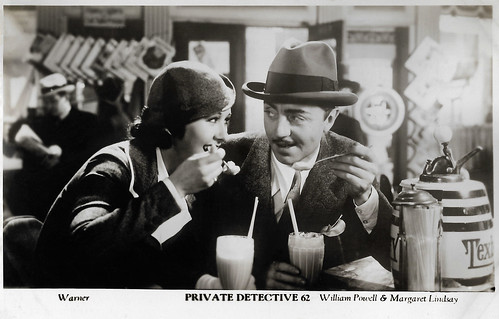
British postcard in the Filmshots series by Film Weekly. Photo: Warner. Margaret Lindsay and William Powell in Private Detective 62 (Michael Curtiz, 1933).

French postcard by E.C., Rueil-Malmaison, no. 556. Photo: Metro-Goldwyn-Mayer (MGM).
A wealthy amateur detective
In 1934, William Powell went to MGM, where he was teamed with Myrna Loy in Manhattan Melodrama (W.S. Van Dyke, 1934) alongside Clark Gable. Their next film together became a classic, the crime comedy The Thin Man (W.S. Van Dyke, 1934), based upon Dashiell Hammett's novel. Powell and Loy co-starred as the wealthy amateur detective duo Nick and Nora Charles who enjoy copious drinking and flirtatious banter. Their wire-haired fox terrier Asta was played by canine actor Skippy. Between 1934 and 1947 Powell and Loy appeared in 14 films together.
While Philo Vance had made Powell a star, Nick Charles made him famous. Powell received an Academy Award nomination for his role in The Thin Man (W.S. Van Dyke, 1934). The role provided a perfect opportunity for Powell, with his resonant speaking voice, to showcase his sophisticated charm and witty sense of humour. The film was such a box-office success that it spawned five sequels: After the Thin Man (W.S. Van Dyke, 1936), Another Thin Man (W.S. Van Dyke, 1939), Shadow of the Thin Man (W.S. Van Dyke, 1941), The Thin Man Goes Home (Richard Thorpe, 1945) and Song of the Thin Man (Edward Buzzell, 1947).
In 1935, William Powell starred with Jean Harlow in Reckless (Victor Fleming, 1935), loosely based on the scandal of the 1931 marriage between torch singer Libby Holman and tobacco heir Zachary Smith Reynolds, and his death by a gunshot wound to the head. A serious romance developed between the two stars. In 1936, they were reunited on screen in the screwball comedy Libeled Lady (Jack Conway, 1936) also with Myrna Loy and Spencer Tracy. Harlow and Powell got engaged, but Harlow became ill soon after and died from uremia at the age of 26 in June 1937 before they could marry.
Powell starred in the Best Picture winner for 1936, The Great Ziegfeld (Robert Z. Leonard, 1936). Powell played the title role and Myrna Loy appeared as Ziegfeld's wife Billie Burke. He received his second Academy Award nomination for the screwball comedy My Man Godfrey (Gregory La Cava, 1936) with his ex-wife Carole Lombard. In March 1938, Powell was diagnosed with rectal cancer. His distress over Jean Harlow's death, as well as the cancer diagnosis, caused him to accept fewer acting roles.
Powell's career slowed considerably in the 1940s till his third Oscar nomination for his work in Life with Father (Michael Curtiz, 1947) with Irene Dunne and Elizabeth Taylor. He had a supporting part in the romantic comedy How to Marry a Millionaire (Jean Negulesco, 1953), starring Betty Grable, Marilyn Monroe, and Lauren Bacall as three fashionable Manhattan models. His last role was in Mister Roberts (John Ford, Mervyn LeRoy, 1955). He played "Doc" alongside Henry Fonda in the title role, James Cagney as the ship's perfectionist captain, and Jack Lemmon in his Oscar-winning performance as Ensign Pulver.
William Powell died of natural causes in Palm Springs in 1984 at the age of 91. He was married three times. His wives were Eileen Wilson (1915-1930), Carole Lombard (1931-1933) and Diana Lewis (1940-1984 - his death). With Wilson, he had a son, television writer and producer William David Powell, born in 1925. After a period of ill health and depression, his son stabbed himself to death while taking a shower in 1968. He left a four-page good-bye letter to his father, with whom he was still very close. The last two sentences were revealed to the public: "Things aren't so good here. I'm going where it's better." Powell was buried at Cathedral City's Desert Memorial Park in Riverside County, California, where his father and his father's last wife, Diana Lewis, are also buried.

British postcard in the Picturegoer Series, London, no. 392a. Photo: MGM.

British postcard in the Film Partners Series, London, no. P 161. Photo: Metro-Goldwyn-Mayer. William Powell and Myrna Loy in Evelyn Prentice (William K. Howard, 1934).

Italian postcard by Ballerini & Fratini, Firenze, no. 3782. Photo: Metro Goldwyn Mayer. Myrna Loy and William Powell. Collection: Marlene Pilaete.
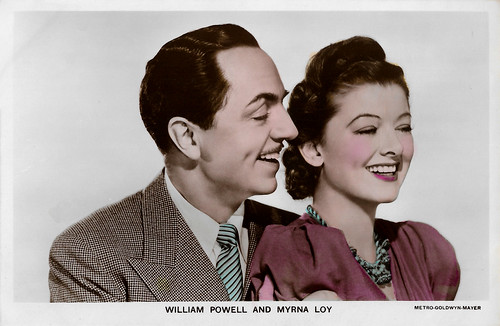
British hand-coloured postcard in the Film Partners Series, London, no. PC 300. Photo: Metro-Goldwyn-Mayer (MGM). William Powell and Myrna Loy in Another Thin Man (W.S. Van Dyke, 1939).
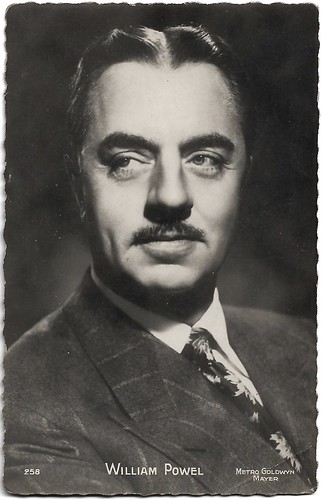
French postcard by Editions P.I., Paris, no. 258, 1946. Photo: Metro-Goldwyn-Mayer.
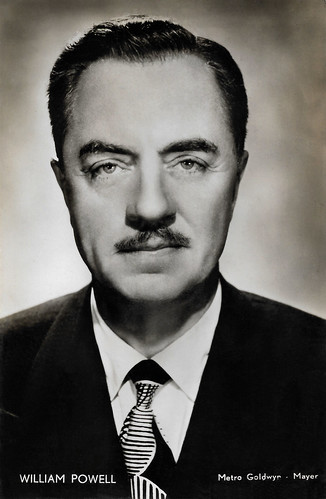
Belgian postcard, no. AX-123. Photo: Metro-Goldwyn-Mayer (MGM).
Sources: Tony Fontana (IMDb), Wikipedia (Dutch and English), and IMDb.
No comments:
Post a Comment